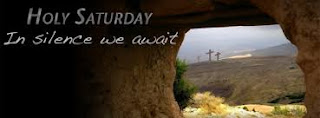Reflection on Holy Week (Third, and last, of three parts)
Holy Saturday - The Paschal Triduum
The last three days of Holy Week are called the Sacred Paschal Triduum, which begins on Holy Thursday.
The Sacred Paschal Triduum is the three most solemn days of the liturgical year: Holy Thursday, Good Friday, and the Easter Vigil. These most holy days celebrate the Paschal Mystery, first, the passion, suffering and death of the Lord Jesus, followed by his resurrection the triumph of the holy cross, and Christ's decisive victory over sin and death.
The Triduum is a single feast, the Paschal Mystery, although celebrated over three days and these are the three holiest days of the entire liturgical year.
Let us reflect on the significance of Holy Saturday.
Holy Saturday (March 31) - Day 3
Holy Saturday, or Black Saturday is the last day of Holy Week, in which Christians prepare for Easter. It commemorates the day that Jesus Christ's body is laid in the tomb. The whole day we keep our spiritual silence, to reflect on God's redeeming love who gave up His only Son to save us from sins.
The sanctuary remains stripped completely bare (following the Mass on Holy Thursday). It reflects our deep sorrow and contrition for Jesus' death.
Liturgically speaking, Holy Saturday lasts until 6 PM or dusk, after which the Easter Vigil is celebrated, making the official start of the Easter season.
Easter Vigil:
The Easter Vigil service starts with the blessing of fire and water, and the lighting of a new Paschal Candle. In the Roman Catholic observance, during the "Gloria" of the Mass, which has been omitted during Lent, the Church statues and icons, in places where they are covered with purple veils during Passiontide, are dramatically unveiled.
 The entire celebration of the Easter Vigil should take place at night time, that is, it should begin after
The entire celebration of the Easter Vigil should take place at night time, that is, it should begin after
After the reading from the Old Testament, the candles at the altar are lit as the priest intones the Gloria. The bells are rung.
Those who participate at the Easter Vigil fulfill their Sunday obligation. But they may still attend regular Easter Sunday Mass and receive Holy Communion.
Finally, the entire Liturgy of the Easter Vigil speaks of our eager expectation of the Resurrection and of its exultant occurrence. The darkness of death has been overcome, the glorious light of Christ has appeared. Christ is Risen! Alleluia! Alleluia! Alleluia!
In sum, the Paschal Triduum is really just one great liturgy, which begins with the Mass of the Last Supper on Holy Thursday, and ends with the final blessing of the Mass on. Easter Vigil. That is why, if you notice, the Mass on Holy Thursday begins with the usual "In the name of the Father...." and the priest's greetings but at the end of the Thursday ceremony the presiding priest just departs silently without any final blessing; it is the same "silent" departure for the ceremony on Good Friday. Also, there is no usual greeting by the priest at the beginning of the liturgy on Good Friday and Easter Vigil. The final blessing is given at the end of the Mass on Easter Vigil. The faithful are encouraged to walk with our Lord to his calvary from Holy Thursday to his final victory on Easter Vigil..... one great Paschal Triduum indeed!
Ad Jesum per Mariam!

No comments:
Post a Comment